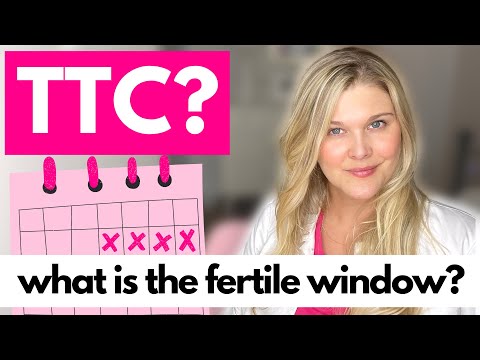A fertile window refers to the period of time in a woman's menstrual cycle when she is most likely to conceive. It is a fascinating and crucial aspect of reproductive health that every woman should be aware of. Understanding and identifying this fertile window can greatly increase the chances of successfully achieving pregnancy, making it a topic of great interest for many couples. The fertile window typically occurs around the midpoint of a woman's menstrual cycle and is influenced by several factors, including the lifespan of sperm and the release of an egg from the ovaries. During this time, the reproductive system is primed for conception, with the cervix producing fertile cervical mucus and the ovaries releasing a mature egg. Many women find the concept of the fertile window intriguing as it allows them to take an active role in family planning or trying to conceive. By tracking their menstrual cycles and monitoring changes in their bodies, women can identify when their fertile window occurs and plan intimate encounters accordingly. For those who are not actively trying to conceive, knowledge of the fertile window can also be beneficial for avoiding pregnancy. Understanding when the chances of conception are highest enables individuals to make informed decisions about contraception methods during this time. In conclusion, the concept of a fertile window is captivating as it holds the key to understanding the optimal time for conception. Whether one is actively trying to conceive or aiming to avoid pregnancy, knowledge of the fertile window empowers individuals to make informed choices about their reproductive health.

Understanding the Fertile Window: Key Information
| Term | Description |
|---|---|
| Ovulation | Ovulation is the release of a mature egg from the ovaries, which usually occurs around the middle of a woman's menstrual cycle. This marks the starting point of the fertile window. |
| Fertile Window | The fertile window refers to a specific timeframe during a woman's menstrual cycle when pregnancy is most likely to occur. It typically spans a few days before and after ovulation. |
| Sperm Lifespan | Sperm can survive inside a woman's body for up to five days, allowing the possibility of conception even if intercourse occurs prior to ovulation. |
| Egg Lifespan | Once released, an egg can survive for approximately 12 to 24 hours. It must be fertilized by sperm within this timeframe to result in pregnancy. |
| Timing Intercourse | To maximize the chances of conception, it is recommended to engage in sexual intercourse during the days leading up to and including ovulation. This ensures the presence of viable sperm in the reproductive tract when the egg is released. |
| Tracking Methods | Several methods can be used to track the fertile window, including monitoring basal body temperature, cervical mucus changes, and using ovulation predictor kits. These methods help identify the most fertile days within the cycle. |
| Variability | It's important to note that the length of the fertile window may vary from woman to woman and can even differ from cycle to cycle. Factors such as stress, illness, and hormonal imbalances can influence its duration. |
Cracking the Code: Unveiling Your Fertile Window and Mastering Cycle Tracking
Understanding the Fertile Window: A Guide to Optimizing Conception
For couples trying to conceive, understanding the concept of a fertile window is crucial. This narrow timeframe in a woman's menstrual cycle is when the chances of pregnancy are at their highest. By knowing when this window occurs, couples can strategically plan their intimate moments, increasing the likelihood of successful conception. In this article, we delve into the intricacies of the fertile window, discussing its definition, signs, and how to accurately track it.
What is the Fertile Window?
The fertile window refers to the period during a woman's menstrual cycle when she is most likely to conceive. It typically spans a few days and occurs just before and during ovulation. Ovulation, the release of a mature egg from the ovaries, marks the peak of a woman's fertility. However, the fertile window also takes into account the lifespan of sperm, as they can survive for up to five days within the female reproductive system.
Signs of the Fertile Window
Recognizing the signs that indicate the onset of the fertile window can greatly assist couples in their journey to conceive. While every woman's body is unique, some common signs can help determine when the fertile window is approaching:
1. Cervical Mucus Changes
The consistency and texture of cervical mucus change throughout the menstrual cycle. During the fertile window, cervical mucus becomes thin, slippery, and stretchy, resembling the consistency of raw egg whites. This type of mucus facilitates sperm movement, providing an optimal environment for fertilization.
2. Basal Body Temperature (BBT) Rise
Tracking basal body temperature can help identify the fertile window. A slight increase in temperature, typically around 0.5 to 1 degree Fahrenheit, occurs after ovulation. By consistently monitoring BBT, couples can pinpoint the day of ovulation and identify the preceding fertile days.
3. Pelvic Pain or Mittelschmerz
Some women experience pelvic pain or a twinge on one side of their lower abdomen during ovulation. This sensation, known as mittelschmerz, can serve as an indicator of the fertile window, alerting couples to engage in intercourse at the optimal time.
Tracking the Fertile Window
Several methods can be employed to accurately track the fertile window and maximize the chances of conception:
1. Calendar Method
The calendar method involves tracking the length of a woman's menstrual cycles to estimate the approximate timing of ovulation. By subtracting 14 days from the length of the shortest cycle, ovulation is estimated to occur. However, this method is less reliable for women with irregular cycles or hormonal fluctuations.
2. Ovulation Predictor Kits (OPKs)
OPKs detect the surge in luteinizing hormone (LH) that occurs 24 to 36 hours before ovulation. These kits provide a more accurate prediction of the fertile window, allowing couples to time intercourse accordingly. However, it is important to note that OPKs do not confirm ovulation; they only indicate the LH surge.
3. Fertility Tracking Apps
Advancements in technology have led to the development of numerous fertility tracking apps. These apps use various tracking methods, such as BBT, cervical mucus, and cycle length, to predict the fertile window. They provide a convenient and accessible way for couples to monitor their fertility and plan intercourse accordingly.
Optimizing Conception during the Fertile Window
Once the fertile window has been identified, couples can take certain measures to optimize their chances of conception:
1. Regular Intercourse
Engaging in regular intercourse every two to three days, especially during the fertile window, ensures that sperm is present in the reproductive system, increasing the chances of fertilization.
2. Healthy Lifestyle
Adopting a healthy lifestyle can positively impact fertility. Maintaining a balanced diet, managing stress levels, regular exercise, and avoiding smoking and excessive alcohol consumption contribute to overall reproductive health.
3. Folic Acid Supplementation
Women planning to conceive are often advised to take folic acid supplements. Adequate folic acid levels reduce the risk of certain birth defects and support the early stages of fetal development.
In conclusion, understanding the fertile window is crucial for couples trying to conceive. By recognizing the signs and accurately tracking this narrow timeframe, couples can optimize their chances of successful conception. Whether through monitoring cervical mucus, tracking BBT, or utilizing fertility tracking apps, the ability to identify and plan around the fertile window offers couples a greater sense of control and confidence on their path to parenthood.

